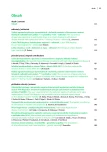Bortezomib-based therapy in patients with light chain deposition disease
Authors:
Jiří Minařík 1; Tomáš Tichý 2; Tomáš Pika 1; Jaroslav Bačovský 1; Dagmar Adamová 3; Karel Srovnalík 4; Karel Krejčí 1; Josef Zadražil 1; Vlastimil Ščudla 1
Authors‘ workplace:
III. interní klinika – nefrologická, revmatologická, endokrinologická LF UP a FN Olomouc, přednosta prof. MUDr. Josef Zadražil, CSc.
1; Ústav klinické a molekulární patologie LF UP a FN Olomouc, přednosta prof. MUDr. Zdeněk Kolář, CSc.
2; Hematologicko-transfuzní oddělení Slezské nemocnice Opava, primářka MUDr. Dagmar Adamová
3; Hematologické a transfuzní oddělení Nemocnice Vsetín, primář MUDr. Karel Srovnalík
4
Published in:
Vnitř Lék 2014; 60(10): 821-826
Category:
Original Contributions
Overview
Light chain deposition disease (LCDD) is a rare systemic condition caused by monoclonal proliferation of terminally differentiated B-lymphocytes with production of free light chains and their deposition in kidneys or other organs. The aim of our study is to show the pitfalls of the diagnostics, and to demonstrate the effect of bortezomib-based therapy on a series of 4 patients with LCDD, from the point of hematological and organ therapeutic response. We include that bortezomib based treatment provides rapid and effective hematological response. It is, however, often accompanied by adverse events, especially within intensive treatment schedules. The most serious adverse effects includes peripheral neuropathy, which might be dose or treatment-limiting. Less intensive regimens („bortezomib weekly“) suggest an alternative with expectation of lower incidence of adverse effects. Autologous stem cell transplantation is a recommended and relatively safe approach in convenient candidates. Organ response is significantly delayed after hematological response, and organ damage by light chain deposits might not be fully reversible.
Key words:
autologous stem cell transplantation – bortezomib – hematological treatment response – light chain deposition disease – organ treatment response
Sources
1. Solomon A, Weiss DT, Herrera GA. Light chain deposition disease In: Mehta J, Singhal S (ed.) Myeloma. 507–518. Martin Dunitz: London 2002. ISBN 9781901865509
2. Ronco P, Plaisier E, Mougenot B et al. Immunoglobulin light (heavy)-chain deposition disease: from molecular medicine to pathology-driven therapy. Clin J Am Soc Nephrol 2006; 1(6): 1342–1350.
3. Heilman HR, Velosa JA, Holley KE et al. Long term follow-up and response to chemotherapy in patients with light chain deposition disease. Am J Kidney Dis 1992; 20(1): 34–41.
4. Hassoun H, Flombaun C, D’Agati VD et al. High-dose melphalan and auto-SCT in patients with monoclonal Ig deposition disease. Bone Marrow Transplant 2008; 42(6): 405–412.
5. Weichman K, Dember LM, Prokaeva T et al. Clinical and molecular characteristics of patients with non-amyloid light chain deposition disorders, and outcome following treatment with high dose melphalan and autologous stem cell transplantation. Bone Marrow Transplant 2006; 38(5): 339–343.
6. Iskandar SS, Falk RJ, Jenette JC. Clinical and pathologic features of fibrillary glomerulonephritis. Kidney Int 1992; 42(6): 1401–1407.
7. Sundaram S, Mainali R, Norfolk ER et al. Fibrillary Glomerulopathy Secondary to Light Chain Deposition Disease in a Patient with Monoclonal Gammopathy. Ann Clin Lab Sci 2007; 37(4): 370–374.
8. Kaplan B, Martin BM, Livneh A et al. Biochemical subtyping of amyloid in formalin-fixed tissue samples confirms and supplements immunohistologic data. Am J Clin Pathol 2004; 121(6): 794–800.
9. Howie AJ. Handbook of Renal Biopsy Pathology. 2nd ed. Springer: Berlin 2007. ISBN 9780387746043.
10. Hájek R, Adam Z, Ščudla V et al (Česká myelomová skupina). Diagnostika a léčba mnohočetného myelomu. Transf Hematol Dnes 2012; 18(Suppl 1): 1S-89S.
11. Ščudla V, Tichý T, Minařík J et al. Onemocnění z depozice lehkých řetězců imunoglobulinu (light chain deposition disease). Klin Biochem Metab 2012; 20(41): 52–58.
12. Kastritis E, Migkou M, Gavriatopoulou M et al. Treatment of light chain deposition disease with bortezomib and dexamethasone. Haematologica 2008; 94(2): 300–302.
13. Kaposztas Z, Kahan BD, Katz SM et al. Bortezomib successfully reverses early recurrence of light-chain deposition disease in a renal allograft: a case report. Transplant Proc 2009; 41(10): 4407–4410.
14. Gasparetto C, Sanchorawala V, Snyder RM et al. Use of melphalan (M)/dexamethasone (D)/bortezomib in AL amyloidosis. J Clin Oncol 2010; 28(Suppl): 579S. Abstr 8024.
15. Gharwan H, Truica C. Bortezomib-based chemotherapy for light chain deposition disease presenting as acute renal failure. Med Oncol 2012; 29(2): 1197–1201.
16. Adam Z, Nedbálková M, Krejčí M et al. Více než 10 let trvání kompletní remise monoklonální gamapatie nejistého významu a vymizení nefrotického syndromu vzniklého na podkladě light chain deposition disease po léčbě vinkristinem, adriamycinem a vysokými dávkami dexametazonu (VAD). Vnitř Lék 2010; 56(3): 240–246.
17. Minarik J, Scudla V, Tichy T et al. Induction treatment of light chain deposition disease with bortezomib: rapid hematological response with persistence of renal involvement. Leuk Lymphoma 2012; 53(2): 330–331.
18. Ščudla V, Minařík J, Pika T Nemoc z ukládání lehkých řetězců imunoglobulinu (light chain deposition disease). Vnitř Lék 2012; 58(1): 38–41.
Labels
Diabetology Endocrinology Internal medicineArticle was published in
Internal Medicine

2014 Issue 10
Most read in this issue
- Therapeutic monitoring of vancomycin in routine clinical practice
- Optimal way of administration of high dose intravenous furosemide – continuous infusion or bolus?
- Monoclonal gammopathy of undetermined significance and asymptomatic multiple myelom in the year 2014
- Gout and cardiovascular risk
